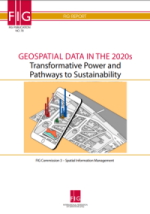FIG PUBLICATION NO. 78
Geospatial Data in the 2020s -
Transformative Power and Pathways to Sustainability
FIG Commission 3 – Spatial Information Management
FIG REPORT
Editors:
Claire Buxton
Marije Louwsma
Hartmut Müller
Markus Schaffert
FOREWORD
Foreword
Megatrends in the 2020s, such as climate change and resource scarcity, rapid
advances in technology like artificial Intelligence and machine learning,
changes in global demographics, in particular the ongoing growth of the
world’s population, the rapid ageing of populations in many countries, and
global migration to megacities, are causing disruptions and will pose major
challenges in the coming years.
Traditionally, land surveyors used to be viewed as ‘measurers’. In recent
years, the surveyor has evolved to a professional who measures, models and
manages all kind of location related data. Surveyors use open standards,
incorporate volunteered information, and ensure interoperability of systems
to deliver knowledge derived from geospatial data of different scales and
origin in the form of user-adapted geospatial information.
Today, geospatial information is widely recognized as an indispensable
source for informed decision making in many fields, such as achieving the
Sustainable Development Goals.
One technological advancement is Earth observation from space, which
provides geospatial data at various spatial, spectral, radiometric and
temporal resolutions and enables the use of the data for a variety of
applications. The COVID-19 pandemic has demonstrated the importance to all
stakeholders of having trusted geospatial health data readily available more
or less in real time. Particularly in less developed regions of our world,
where officially maintained geospatial data sets are a scarce resource,
citizen input of volunteered geographic information can be very valuable.
Digital land administration platforms can provide ready to use geospatial
data to support emergency response, climate change response, disaster and
conflict management, health management, spatial land use planning, real
estate market stimulation, infrastructure provision, protection of women and
vulnerable groups, and business activation and citizen action.
This FIG report sheds light on several areas where geospatial data can be
particularly useful in supporting the path to sustainability in the 2020s,
for spatial land use planning and health monitoring, with data collection
through voluntary geographic information, with attention to diversity and
inclusion, and by providing information on property, including property
values.
This FIG-publication is the result of a very fruitful cooperation between
the FIG Commissions 3 and 8 together with VCSP (Volunteer Community Surveyor
Program) of the Young Surveyors Network over the last years.
Many people of these groups contributed to this publication. My
congratulations and special thanks go to Hartmut Müller (Chair C3), Marije
Louwsma (Chair C8), Markus Schaffert (Vice Chair C3), Claire Buxton, Roshni
Sharma, and Tom Kitto (all VCSP) including all the working group chairs of
C3 and C8.
Rudolf Staiger
President of International Federation of Surveyors
Chapters
Chapter 1: eospatial Data and Sustainability – Setting the Frame
Chapter 2: The nexus of Spatial Planning and Geospatial Information
Chapter 3: The Spatial Dimension of Health
Chapter 4: Geospatial Data and the Changing Society
Chapter 5: Participation and Spatial Empowerment
Chapter 6: The Role of Land Administration Data in the Real Estate Sector
Chapter 7: Discussion and Conclusions
Read the full FIG Publication 78 in pdf
Copyright © The International Federation of Surveyors (FIG),
September 2022.
All rights reserved.
International Federation of Surveyors (FIG)
Kalvebod Brygge 31–33
DK-1780 Copenhagen V
DENMARK
Tel. + 45 38 86 10 81
E-mail: FIG@FIG.net
www.fig.net
Published in English
Copenhagen, Denmark
ISSN 2311-8423 (pdf)
ISBN 978-87-93914-01-8 (pdf)
Published by
International Federation of Surveyors (FIG)
Layout: Lagarto
|
























